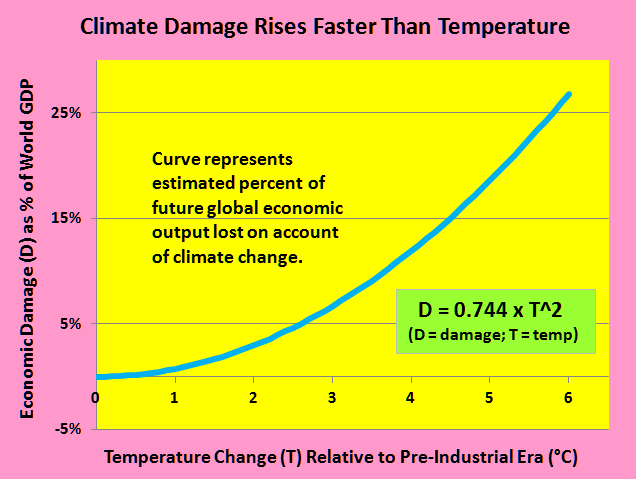David Wallace-Wells, the writer for New York magazine who jolted us last year with his searing climate-change story, The Uninhabitable Earth, has posted a follow-up, UN Says Climate Genocide Is Coming. It’s Actually Worse Than That.
You guessed right, the sequel is about the new IPCC report. We began the week covering the report’s first-time recommendation of a high carbon price to drive emission reductions. We can’t fully do justice to Wallace-Wells’ latest with a summary — it’s too layered for that. To convey a sense of his argument and his urgency, we’re excerpting five key passages (disclosure: some are longer than mere sentences), with comments.
David Wallace-Wells: Barring the arrival of dramatic new carbon-sucking technologies, which are so far from scalability at present that they are best described as fantasies of industrial absolution, it will not be possible to keep warming below two degrees Celsius — the level the new report describes as a climate catastrophe. As a planet, we are coursing along a trajectory that brings us north of four degrees by the end of the century. The IPCC is right that two degrees marks a world of climate catastrophe. Four degrees is twice as bad as that. And that is where we are headed, at present — a climate hell twice as hellish as the one the IPCC says, rightly, we must avoid at all costs. (emphasis added)

Doubling the rise in temperature quadruples the anticipated damage. We drew up this curve to illustrate our June 2017 post, “Showing the Cost Side of the Climate Equation in a New Light.”
Carbon Tax Center: It’s worse than that. The most likely “shape” of the planetary climate-damage curve (or function) is a quadratic. (See graphic, from our June 2017 post, Showing the Cost Side of the Damage Equation in a New Light.) Doubling the temperature rise doesn’t double the damage, it quadruples it. Tripling the rise magnifies the damage nine-fold. The silver lining, if there is one, is that each increment of temperature rise we can prevent through societal action pays back more than proportionately in damage avoidance.
DW-W [this sentence is from his previous passage]: New carbon-sucking technologies … are so far from scalability at present that they are best described as fantasies of industrial absolution.
CTC: We agree.
DW-W: Because the numbers are so small, we tend to trivialize the differences between one degree and two, two degrees and four. Human experience and memory offers no good analogy for how we should think about those thresholds, but with degrees of warming, as with world wars or recurrences of cancer, you don’t want to see even one.
CTC: Goodness, yet another way in which human cognition militates against fully grasping and grappling with climate change. We thought Dale Jamieson’s magnificent 2014 book, Reason in a Dark Time: Why the Struggle Against Climate Change Failed, and What It Means for Our Future, covered all the obstacles to understanding and action: It’s hard to attribute the myriad consequences we see in the world to climate change… Evolution built us to respond to “rapid movements of middle-sized objects,” not to the slow buildup of insensible gases in the atmosphere. And of course, climate change is the world’s largest and most complex “collective action problem,” in which each of us, acting on our own desires, contributes to outcomes we neither desire nor intend. And many more, to which Wallace-Wells has added the new one, above.
DW-W: Nothing in the IPCC report is news … not to the scientific community or to climate activists or even to anyone who’s been a close reader of new research about warming over the last few years. That is what the IPCC does: It does not introduce new findings or even new perspectives, but rather corrals the messy mass of existing, pedigreed scientific research into consensus assessments designed to deliver to the policymakers of the world an absolutely unquestionable account of the state of knowledge.
CTC: That’s helpful to those of us in the trenches. It aids us in seeing why the release of old news — include the lede that limiting the earth’s average temperature rise to 1.5°C is pretty much off the table — was served up by important media as news, period.
DW-W: The IPCC has also, thankfully, offered a practical suggestion, proposing the imposition of a carbon tax many, many times higher than those currently in use or being considered — they propose raising the cost of a ton of carbon possibly as high $5,000 by 2030, a price they suggest may have to grow to $27,000 per ton by 2100. Today, the average price of carbon across 42 major economies is just $8 per ton. The new Nobel laureate in economics, William Nordhaus, made his name by almost inventing the economic study of climate change, and his preferred carbon tax is $40 per ton — which would probably land us at about 3.5 degrees of warming. He considers that grotesque level “optimal.”
CTC: Yesterday we posted the comment by our colleague Thomas Sterner, declaring that Nordhaus’s “choice to label the 3.5°C [temperature rise] as optimal is … unfortunate.” Today we would rather dwell on the brighter side, that the IPCC for the first time called not just for a carbon price but for a high one, as we reported on Monday.
DW-W: A carbon tax is only a spark to action, not action itself.
CTC: Yes … and no. No, because a robust carbon tax will be far more than a mere spark — it will stimulate enormous changes in behavior, investment, decision-making and innovation, all of it toward vastly lessened use of carbon fuels. Yes, because the tax itself doesn’t reduce emissions, rather it instills incentives that will provoke the reductions.
We think the article is well worth reading. Let us hear your take.
